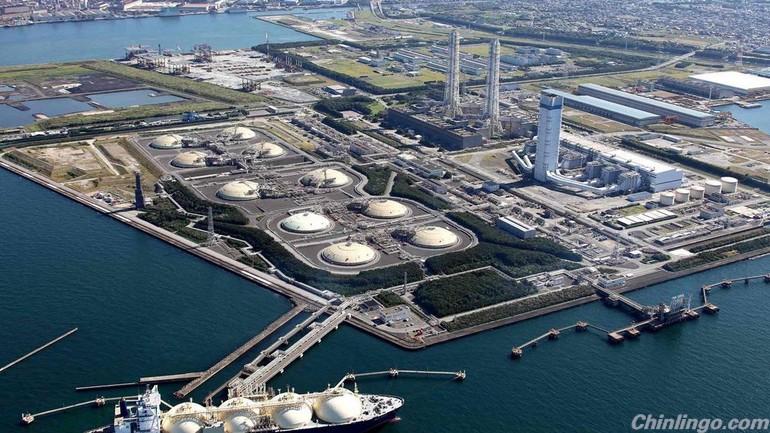
The thick smog that blankets many Chinese cities represents a vast commercial opportunity for emerging market suppliers of gas, a clean-burning fuel.
笼罩中国不少城市的浓重雾霾给新兴市场的天然气供应商带来了巨大的商业机遇。天然气是一种清洁燃料。
As pollution levels approached choking point this winter, China’s imports of liquefied natural gas (LNG) surged 38 per cent – partly because of a deepening environmental consciousness and partly because temperatures plumbed 28-year lows, analysts said.
随着去年冬季的空气污染逼近令人窒息的程度,中国液化天然气进口量猛增了38%。分析师指出,其中部分原因在于人们的环境意识加强,还有部分原因是去年冬季的气温降至近28年来的最低水平。
This rate of increase exceeded even the strong 25 per cent average annual increase in LNG imports seen over the past four years, suggesting a potential inflection point in Chinese demand, according to Point Carbon, a consultancy. Over the next four years, China could see as much as a quadrupling in LNG import volumes, it added. Last year, China imported 24.7bn cubic metres of gas in the form of LNG, 15 per cent of its total gas imports.
咨询公司汤森路透碳点指出,过去四年间,中国液化天然气进口量的年均增幅高达25%,如今增幅显著扩大,表明中国的液化天然气需求可能即将迎来转折点。汤森路透碳点补充称,未来四年中国的液化天然气进口量可能增长三倍。去年中国进口液化形态的天然气247亿立方米,占中国天然气进口总量的15%。
Most of China’s electricity is generated from coal but the pollution it causes has become a potentially incendiary social issue. Pollution levels have risen to as much as 40 times the maximum safe limit laid down by the World Health Organisation. A recent survey conducted by WPP, the international advertising giant, found that 85 per cent of Chinese were worried about the environment. The pressure on Beijing to restructure its energy mix is intense.“By 2020, China could easily be the world’s largest LNG importer,” says Bjorn Brochmann, head of gas research and forecasts at Point Carbon.
中国主要依靠燃煤发电,但这种发电方式所导致的污染已经成为了一大社会问题。中国污染最严重时达到了世界卫生组织颁布的污染物浓度安全上限的40倍。国际广告业巨头WPP近期进行的一项调查发现,85%的中国人对环境问题深感担忧。中国政府面临调整能源结构的沉重压力。汤森路透碳点的天然气研究和预测主管比约恩·布罗克曼表示:“到2020年,中国有很大可能成为全球第一大液化天然气进口国。”
New liquefecation terminals in Algeria, Papua New Guinea and Australia are all scheduled to open this year, adding supply to the market. China has already secured a portion of this under long term contracts. Qatar is China’s largest source of LNG, supplying a third of its total imports, followed by Australia, Indonesia and Malaysia.
阿尔及利亚、巴布亚新几内亚和澳大利亚新建的一批液化天然气站点预计今年都将投入使用,这将增大市场中的供给量。中国已经通过长期合同的形式预定了这批供给中的一部分。卡塔尔是中国第一大液化天然气来源,中国进口总量中有三分之一来自该国,排在其后的是澳大利亚、印度尼西亚和马来西亚。
Over the next five years, more LNG terminals are scheduled to be commissioned in Malaysia, Australia, Indonesia, Algeria, Colombia, the US and Russia. While developers of the new projects are unlikely to struggle to find buyers, China’s increased thirst for gas is good news for exporters keen to see the LNG price stay high.
未来五年中,马来西亚、澳大利亚、印度尼西亚、阿尔及利亚、哥伦比亚、美国以及俄罗斯等国将有更多的液化天然气站点投入使用。这些新项目的开发商不太可能为了寻找买家而大费周章,而对于乐于看到液化天然气价格保持高位的出口商来说,中国对天然气的需求上升是一个好消息。
Becoming one of the world’s largest gas buyers puts China in an influential position, particularly if it can join forces with other major LNG buyers in Asia in a bid to manage prices. However, it also ties China to the global LNG market, leaving a large portion of its energy supply at the mercy of price fluctuations.
成为全球主要天然气购买方使中国具有了很强的市场影响力,特别是如果中国能与亚洲其他主要液化天然气买方展开协作,共同影响天然气价格。但这种市场地位也将中国与全球液化天然气市场紧密地联系到了一起,使中国很大一部分能源供给要承受国际市场价格波动。
The price of LNG has changed significantly over time. LNG from Malaysia costs China $3 – $4 per million British thermal units, on supply agreements signed several years ago. China’s more recent deal with Qatar is priced at $18 per mmbtu.
液化天然气价格的变化很大。根据几年前签署的供给协议,中国从马来西亚购买液化天然气的价格为每100万英热单位3至4美元。而在中国与卡塔尔最近签署的采购协议中,每100万英热单位的价格为18美元。
In addition, liquefecation projects are expensive and prone to delay, leaving China potentially vulnerable to a shortfall in supply.
除此之外,液化工程造价昂贵,并且很容易出现延期,这使得中国有可能陷入天然气供给短缺的局面。
China has opted to take that risk. “For many years the Chinese government has talked about increasing the role of natural gas in China’s energy mix,” says Erica Downs, a Brookings Institution fellow. Tackling China’s power sector first makes sense. Around 47 per cent of China’s sulphur dioxide emissions and 69 per cent of nitric oxide and nitrogen dioxide emissions come from power generation.
中国已经选择接受这种风险。布鲁金斯学会的研究员邓丽嘉表示:“多年以来,中国政府一直在谈提升天然气在中国能源结构中的地位。”先从中国电力行业开刀是合理的。中国约有47%的二氧化硫排放以及69%的一氧化氮和二氧化氮排放来自发电过程。
But while China has increased its LNG imports significantly, they still meet only 15 per cent of the country’s gas needs. China pipes in a significant amount of gas from Turkmenistan and is negotiating with Gazprom for Russian gas supplies from 2018.
虽然中国显著扩大了液化天然气的进口规模,但它们仅满足了中国15%的天然气进口需求。中国通过管道从土库曼斯坦输入了大量天然气,并正在与俄罗斯天然气工业股份公司就自2018年起输入俄罗斯的天然气展开谈判。
China is also producing a lot more of its own gas. Its gas production is now roughly the same as that of Norway, western Europe’s largest gas producer, and meets around 60 per cent of its gas needs. If hopes of a shale gas revolution are realised, China may produce even more gas.
中国的自产天然气规模也有很大增长。目前中国的天然气产量已基本与挪威相当——挪威是西欧最大的天然气生产国——大约能够满足国内60%的天然气需求。如果页岩气革命能够成功,中国将能生产出更多的天然气。
LNG imports will nevertheless continue to be crucial to ensuring that China has enough gas to meet growing electricity demand and reduce its coal-burning capacity. “We have seen rates of 15 per cent of annual growth in electricity demand,” says Brochmann. “Even if you import a lot of gas, coal usage is so huge that it continues to go up.”
但液化天然气进口仍将具有关键作用,保证中国能够拥有足够的天然气资源以满足日益增长的电力需求并缩减燃煤发电产能。布罗克曼表示:“我们看到,中国的电力需求年均增幅达到了15%。即便大规模进口天然气,煤炭的使用量仍然颇为庞大并将继续走高。”
While it’s a big task, it is necessary for China to tackle its “airpocalypse.”
中国必须着手解决“空气末日”问题,虽然这是一个庞大而艰巨的工程。
“When Beijing closes its existing coal-fired plants, the most reliable way is to replace coal with gas,” says Hongliang Chai, analyst at Point Carbon. “We estimate that 3.69 bcm of gas will be needed by 2015 – and 5.35 bcm by 2018 – to replace coal in the city’s power and gas sectors.”
汤森路透碳点的柴洪亮表示:“当中国政府关停现有的燃煤发电厂时,最可靠的办法是用天然气替代煤炭。我们估计,为了替代城市电力和天然气产业中所使用的煤炭,2015年中国需要36.9亿立方米天然气——到2018年该数字或将达到至53.5亿立方米。”
Importing more LNG will make China more dependent on other emerging markets as it will need to secure new sources of supply. China has just become the world’s largest net importer of oil, tying its fortunes more tightly to international energy markets. Surpassing Japan as the world’s largest LNG buyer will be China’s next significant energy milestone.
扩大液化天然气进口将使中国更加依赖其他的新兴市场国家,因为中国将需要获得新的供给来源。中国现已成为全球第一大石油净进口国,这使中国的发展前景更加紧密地与国际能源市场联系在一起。超过日本成为全球最大的液化天然气进口国将成为中国能源发展道路上的下一个重要里程碑。



 闽公网安备 35020302035673号
闽公网安备 35020302035673号
0 responses on "China smog a boon for EM suppliers of LNG "